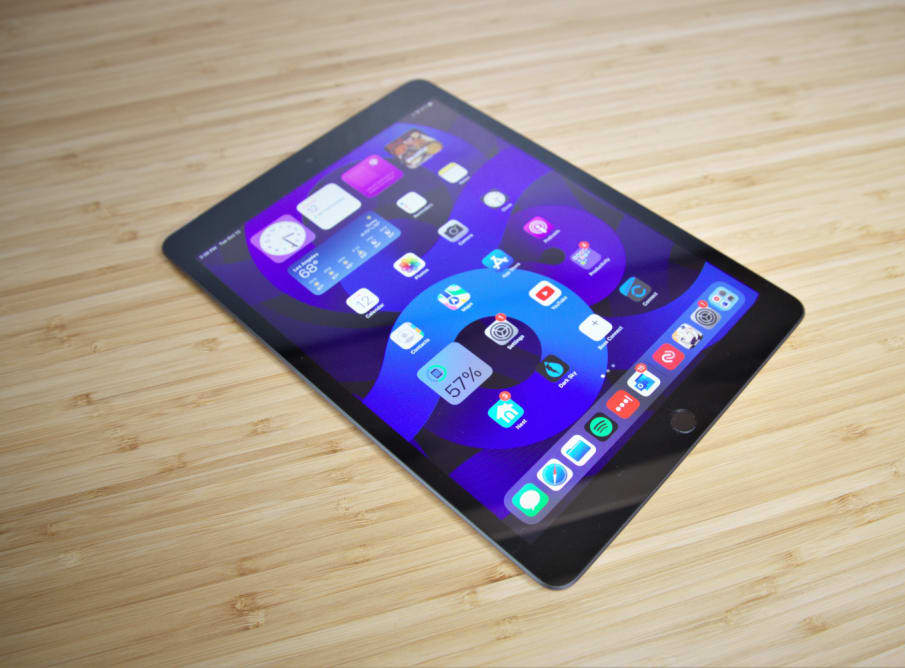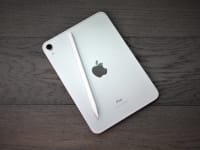Pros
-
Great performance
-
Extremely versatile
-
Excellent value
Cons
-
Display could use an upgrade
-
Weak speakers
-
Design feels old
About the Apple iPad (9th-gen)
- Chipset: Apple A13 Bionic
- Display: 10.2-inch Retina LCD display
- RAM: 3GB
- Storage: 64GB, 256GB
- Rear-facing camera: 8MP wide angle
- Front-facing camera: 12MP ultra wide angle
- Wired connectivity: Lightning
- Wireless connectivity: Bluetooth 5, Wi-Fi 6, optional Cellular 5G/4G LTE
- Colors: Space Gray, Silver
The 9th-gen iPad upgrades the internals from the A12 Bionic to the A13 Bionic, expands the base model’s storage from 32GB to 64GB, delivers an upgrade to the front-facing camera, and adds True Tone to the display.
What we like
The iPad is a true jack of all trades
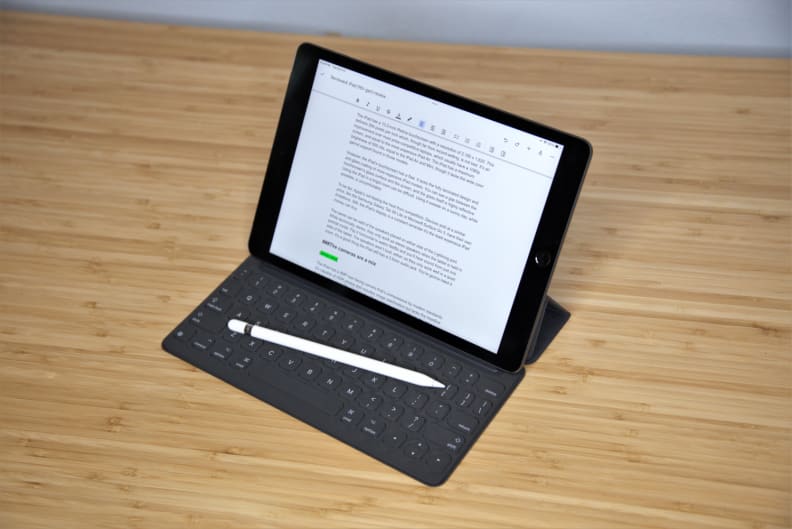
If you need a portable device that can do it all, look no further than the Apple iPad 9th-gen.
The iPad’s combination of versatility and value is unrivaled not just by other tablets, but by any other computing device available today.
It’s capable straight out of the box. The large touchscreen, while inferior to more expensive iPad models and the best Android tablets, can handle most tasks with ease. From Netflix to Excel, the iPad responds quickly to your touch and delivers a vivid, bright, usable experience. But it goes deeper than that.
The iPad is a solid gaming device, especially if you sign up for Apple Arcade or use a cloud gaming service like Google Stadia. It feels fast and fluid when editing all but the largest photos and videos. Buy the first-gen Apple Pencil, a $99 accessory, and the iPad becomes a capable note-taking machine and a great entry-level device for creating digital art. Need to write a term paper or a business plan? Pair a Bluetooth keyboard and mouse or buy a keyboard case.
This isn’t to say the iPad is the best at any of these tasks. A Nintendo Switch is better for gaming, a beefy desktop is better for video editing, and a Wacom tablet connected to a workstation PC (or Mac) is better for digital artists. However, the iPad is good enough at all these tasks to handle the job for most people.
Sized perfectly
iPadOS, Apple’s tablet-centric spin on iOS, currently ships on five iPad tablets with a screen size from 8.3 to 12.9 inches. The iPad’s 10.2-inch lands comfortably between these extremes and feels like the “right” display size for the operating system.
The iPad Mini’s home screen feels awkward. It’s a bit cramped when held in portrait, yet feels underutilized in landscape orientation, and text is often very small. The 12.9-inch iPad Pro, on the other hand, feels underutilized. The dock is more compact than it needs to be and apps often look overly large with too much unused space.
The iPad doesn’t have these issues. It looks right in both landscape and portrait orientation, with great spacing between icons and plenty of room for widgets. The dock takes up most of the screen, but individual dock icons remain large and easy to see. Text is easily readable for those privileged with good eyesight and the larger overall screen size (compared to the Mini) provides room for adjustment if you need to make text larger.
That’s good news for value shoppers. The base iPad is affordable, yet opting for it doesn’t mean ditching key features of iPadOS. On the contrary, iPadOS is better on the iPad than on some more expensive iPad models. It’s great that Apple offers smaller and larger iPads for those who prefer them, but the iPad (along with the iPad Air and 11-inch iPad Pro) is clearly the benchmark for which iPadOS was designed.
Great performance on a budget
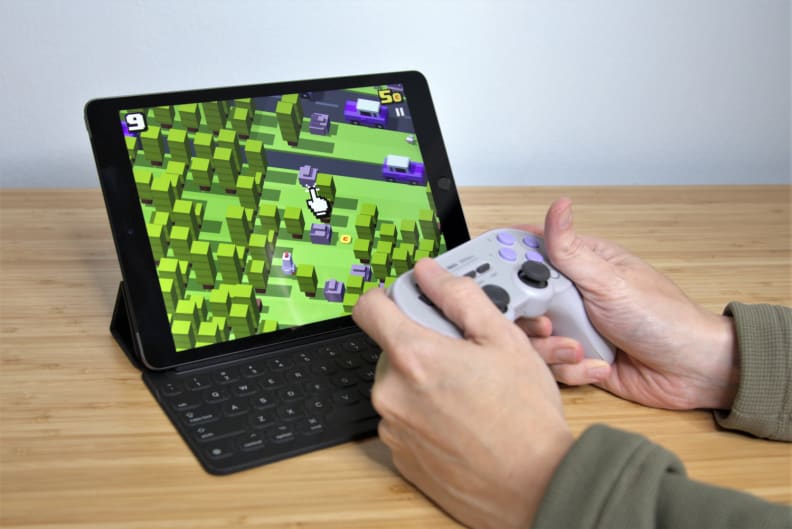
Thanks to compatible cloud gaming platforms, the 9th-gen iPad doubles a portable gaming machine.
Apple’s A13 Bionic powers the latest iPad. First released in 2019, the A13 is not Apple’s latest and greatest but delivers a decent upgrade over the prior iPad’s A12 Bionic.
The Geekbench 5 benchmark, which measures raw processing performance, reached a single-core score of 1331 and a multi-core score of 3346. The single-core score is impressive, as it’s barely behind the single-core performance of a premium laptop with Intel’s 11th-gen Core processor; The Dell XPS 13 OLED, with an as-tested MSRP of $1,439.99, scored 1441 in this benchmark.
The multi-core score is less exciting but in the ballpark of devices like the Microsoft Surface Go and Acer Spin 3, which generally score between 3000 and 4000 depending on the processor. This remains a solid result for the iPad, as PC-based competitors are more expensive.
Of course, the iPad’s secret sauce is iPadOS itself which, compared to Windows, is more focused and efficient. The numbers say a Surface Go 3 and iPad should feel similar, but the difference is night-and-day in favor of the iPad. The Surface Go can seem reluctant even when browsing the web or switching between documents. The iPad never skips a beat, loading, and switching between (most) apps as quickly as you can use the touchscreen.
The iPad’s graphics performance is less or more exciting, depending on your perspective. Geekbench ML’s GPU test reached a score of 7288 which, for an iPad, is just ok. It’s ahead of the 2nd-gen iPad Pro but well behind the latest iPad Air, which scores 12488.
Still, the iPad handles modern 3D games well. Genshin Impact felt a bit sluggish at the game’s High detail preset, but it was smooth at the Medium preset. The iPad is a far better gaming device than a budget Windows 2-in-1 with Intel HD graphics.
Battery life is similar to other iPads. In regular use, I charged the iPad once every two days, and I never saw the battery dip below 25%. The iPad lasted just over 10 hours while playing a video loop. This is about the same as past models but still solid for a budget tablet.
You won’t find a better value
There’s a lot of reasons to like the iPad, but the best reason remains the price.
The basic iPad starts at $329 for 64GB of storage. This is an upgrade from the 8th-gen iPad, which had only 32GB in its $329 configuration. Some might argue the storage is still too lean, but I think it’s fine for an entry-level tablet (my older iPad Pro also has 64GB of storage, and I manage).
You can spend more. The top-tier 256GB Wi-Fi + Cellular model we received from Apple will set you back $609. That’s a great price for a tablet with mobile data but not budget-friendly. The model I tested was bundled with the $99 Apple Pencil and $159 Smart Cover for an all-in price of $867.
That may seem steep, but it remains competitive. To find similar features in a Surface device you must go for the new Surface Pro 8 which, after keyboard and stylus, costs around $1,400. Android fans have a more affordable choice in the Galaxy Tab S7, which is available for $829.99 with keyboard and stylus included, but it lacks mobile data.
But obsessing over the top-tier iPad is missing the point; The $329 iPad is a great tablet that can handle anything most owners will throw at it. Slap on Logitech’s $149.99 Combo Touch (which we recommend over Apple’s $159 Smart Keyboard) and it becomes a great 2-in-1 for less than $500.
What we don’t like
Display and audio need an upgrade
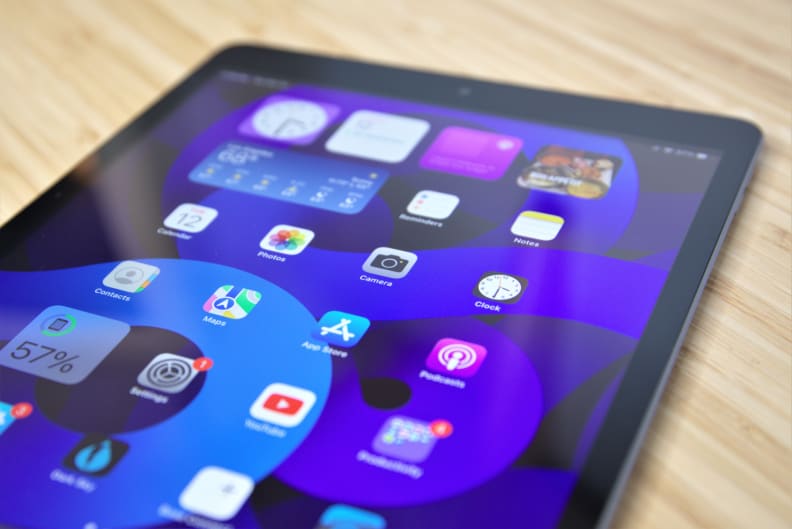
The latest iPad doesn't have the best audio, so make sure you have a good pair of headphones.
The iPad has a 10.2-inch Retina touchscreen with a resolution of 2160 x 1620. This delivers 264 pixels per inch which, though far from record-setting, is not bad. It’s an improvement over most price-competitive laptops, which usually have a 1080p screen, and are equal to the more expensive iPad Air. The iPad has a maximum brightness of 500 nits, equal to the iPad Air and Mini, though it lacks the wide color gamut support found in those models.
However, the iPad’s touchscreen has a flaw: It lacks the fully laminated design and anti-glare coating of more expensive iPad models. You can see a gap between the touchscreen’s glass surface and the screen, and the glass itself is highly reflective. Using the iPad in a bright room can be difficult. Using it outside on a sunny day, while possible, is uncomfortable.
Apple’s not feeling the heat from competitors. Devices sold at a similar price, like the Samsung Galaxy Tab S6 Lite or Microsoft Surface Go 3, have their own limitations. Still, the iPad’s display is a constant reminder it’s the least expensive iPad money can buy.
The same can be said of the speakers placed on either side of the Lightning port. While technically stereo, they only work as stereo speakers when the tablet is held in portrait mode. Flip it horizontal to watch Netflix and you’ll hear sound from just one side of the tablet. The speakers aren’t loud, either, so they only work well in a quiet room. It’s a good thing the iPad still has a 3.5mm audio jack. You’re gonna need it.
So-so cameras, missing features
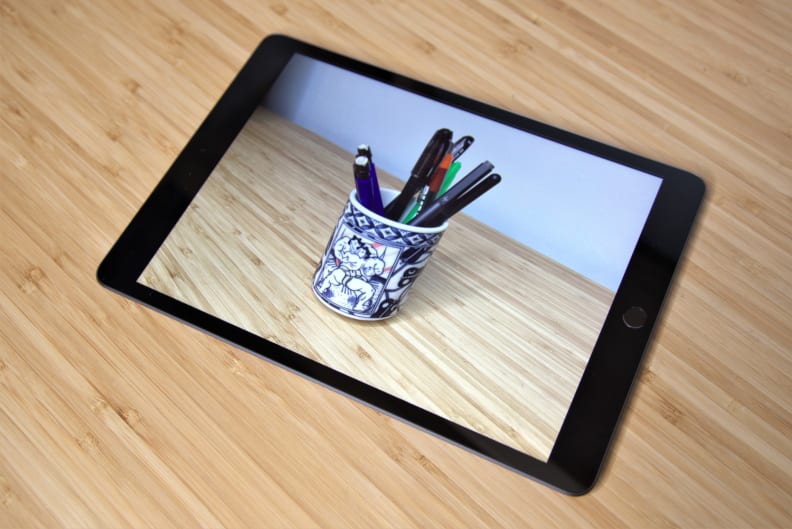
While the 9th-gen iPad has a great front-facing camera, the rear one could be better.
The iPad has an 8MP rear-facing camera that’s unimpressive by modern standards. It’s capable of HDR photos and includes image stabilization but lacks the headline features of modern iPhones including Portrait Mode and Night Mode. Its video capabilities are modest, as well, with 1080p supported at only 30 FPS and Slo-mo available only at 720p and 120 FPS. Sorry, aspiring YouTube stars: 4K video capture is not supported.
Unlike an iPhone, the iPad’s front-facing camera takes priority. It’s a 12MP ultrawide camera capable of 1080p at up to 60 FPS. This is a massive upgrade from the prior iPad’s rather dreadful 1.2MP (yes, 1.2!) camera. However, the camera still lacks features you might expect including Portrait Mode. I find the lack of Portrait Mode odd given its inclusion in the iPhone SE which, on paper, appears to have similar specifications to the 9th-gen iPad.
Despite these flaws, the front-facing camera’s resolution deserves praise. Most modern laptops ship with a 720p camera, no matter their price. The iPad’s front-facing camera is a stark improvement over what you’ll find in price-competitive PCs.
Old-school design past its prime
The iPad’s design has changed little over the years. Its last major redesign came with 2019’s 7th-gen update, which switched from a 9.7-inch to 10.2-inch display and tweaked the iPad’s dimensions. Still, the modern iPad looks remarkably similar to the original iPad released over a decade ago.
This is most noticeable when lifting the iPad to use it. It weighs in at a hair over one pound and is about three-tenths of an inch thick. The iPad Air, by comparison, weighs just one pound and is a quarter of an inch thick.
The difference seems unremarkable on paper, but the iPad feels a bit more awkward to handle than the Air or 11-inch iPad Pro. The extra weight and bulk make the tablet more eager to escape your grasp.
The old-school design also means thick display bezels and the absence of Apple’s modern Face ID facial recognition login. we’re more willing to forgive these features on the budget-friendly iPad than on the more expensive iPad Mini, but hopefully, Apple will roll out a thin-bezel design and Face ID to all devices in the future. Apple’s big, round Face ID button is a relic from another era of Apple design, but it’s more intuitive and responsive than the narrow Touch ID power button on the flanks of the iPad Air and Mini.
Should you buy the Apple iPad (9th-gen)?
Yes, the 9th-gen iPad offers excellent value
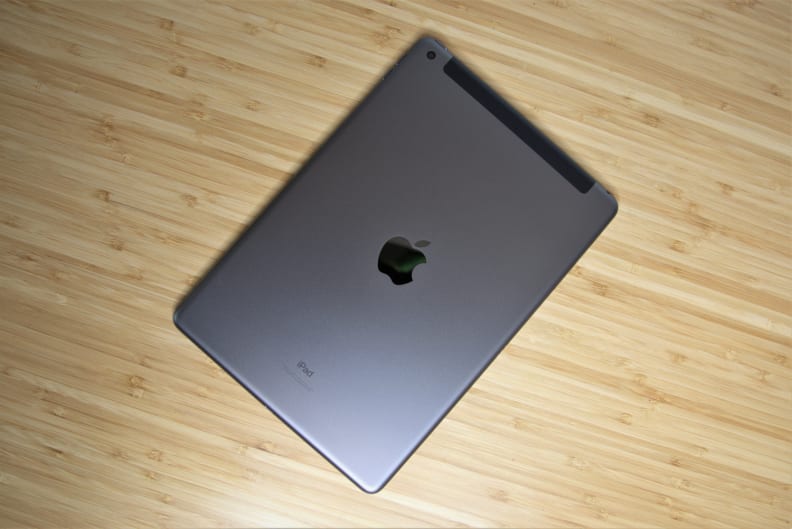
The iPad's design hasn't changed much over the years, for better and worse.
The 9th-gen Apple iPad is one of the best budget tablets, best budget computer, and all you need to experience the bulk of what Apple has to offer. Compared to other iPad models, the iPad is clearly the best value. Yes, the iPad Pro is faster, has Face ID, and has a nicer display. That’s all great, but also optional. You’ll be hard-pressed to find an app on the App Store that doesn’t perform well on the iPad. The iPad also supports every key Apple service and accessory: Arcade, iCloud, TV+, Pay, Handoff, iMessage, the first-gen Apple Pencil, and more.
The value holds up if you consider competitors. Samsung has a few good tablets, but the Android operating system hasn’t prioritized features useful to tablets and 2-in-1s such as external mouse support and multi-tasking. Both features are present in Android but executed with less elegance than iOS. Android also has an app support issue. Apps often lack tablet-specific support and instead work as oversized smartphone apps.
That leaves Windows and ChromeOS 2-in-1s like the Microsoft Surface Go, Acer Spin, or HP Chromebook x360 series. Some are great, but price-competitive models often pack Intel Pentium or Celeron processors that lag behind the iPad’s A13 Bionic. Windows also has an issue with app support, as many legacy applications are difficult to use with a touchscreen.
There are reasons to buy a budget Windows or ChromeOS 2-in-1 over an iPad. Perhaps you prefer Windows (or ChromeOS), need external monitor support, or have a grudge with Apple’s App Store. For most people, however, the iPad is the clear victor. Nothing else comes close.
Meet the tester
Matthew S. Smith is a veteran tech journalist and general-purpose PC hardware nerd. Formerly the Lead Editor of Reviews at Digital Trends, he has over a decade of experience covering PC hardware. Matt often flies the virtual skies in Microsoft Flight Simulator and is on a quest to grow the perfect heirloom tomato.
Checking our work.
Our team is here to help you buy the best stuff and love what you own. Our writers, editors, and experts obsess over the products we cover to make sure you're confident and satisfied. Have a different opinion about something we recommend? Email us and we'll compare notes.
Shoot us an email

